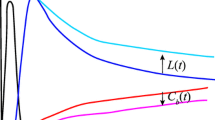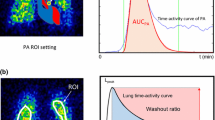Abstract
Objective
Iodine-123 (123I)-labeledN-isopropyl-4-iodoamphetamine (IMP) has been used as a cerebral blood flow (CBF) tracer for single-photon emission computed tomography (SPECT). An autoradiographic (ARG) method has been developed for the quantitation of CBF by IMP and SPECT. Two IMPs (IMPA and IMPB) produced by different radiopharmaceutical companies are marketed in Japan. In the present study, whole-body distributions including brain and blood of the two IMPs were compared in the same human subjects.
Methods
Two brain SPECT studies using IMPa or IMPb were performed on separate days in six young healthy men. Whole-body scans were also obtained with a large field-of-view single-head gamma camera. One-point arterial blood sampling was performed at 10 min after injection of IMP to measure both the radioactivity concentrations of whole blood and of octanol-extracted components.
Results
No significant differences between the two tracers were observed in body distribution, tracer kinetics in brain, or regional distribution in brain. However, the octanol extraction fraction in blood was significantly different between the two tracers. Radiochemical purity was slightly but significantly different between the tracers.
Conclusions
In the ARG method, arterial input function is determined by calibration of a standard input function with the radioactivity concentration of arterial whole blood. Because the standard input function in the ARG method was obtained using IMPa, the standard input function obtained for IMPb should be used when CBF is calculated by the ARG method with IMPB
Similar content being viewed by others
References
Winchell HS, Baldwin RM, Lin TH. Development of I-123- labeled amines for brain studies: localization of I-123 iodophenylalkyl amines in rat brain.J Nucl Med 1980; 21: 940–946.
Winchell HS, Horst WD, Braun L, Oldendorf WH, Hattner R, Parker H. AMsopropyl-[123I]p-iodoamphetamine: single- pass brain uptake and washout; binding to brain synaptosomes; and localization in dog and monkey brain.J Nucl Med 1980; 21: 947–952.
Ito H, Iida H, Bloomfield PM, Murakami M, Inugami A, Kanno I, et al. Rapid calculation of regional cerebral blood flow and distribution volume using iodine- 123-iodoam- phetamine and dynamic SPECT.J Nucl Med 1995; 36:531- 536.
Iida H, Itoh H, Nakazawa M, Hatazawa J, Nishimura H, Onishi Y, et al. Quantitative mapping of regional cerebral blood flow using iodine-123-IMP and SPECT.J Nucl Med 1994; 35: 2019–2030.
Ito H, Ishii K, Atsumi H, Inukai Y, Abe S, Sato M, et al. Error analysis of autoradiography method for measurement of cerebral blood flow by123I-IMP brain SPECT: a comparison study with table look-up method and microsphere model method.Ann Nucl Med 1995; 9: 185–190.
Iida H, Akutsu T, Endo K, Fukuda H, Inoue T, Ito H, et al. A multicenter validation of regional cerebral blood flow quantitation using [123I]iodoamphetamine and single photon emission computed tomography.J Cereb Blood Flow Metab 1996; 16: 781–793.
Ogasawara K, Ito H, Sasoh M, Okuguchi T, Kobayashi M, Yukawa H, et al. Quantitative measurement of regional cerebrovascular reactivity to acetazolamide using123I-N- isopropyl-p-iodoamphetamine autoradiography with SPECT: validation study using H2 15O with PET.J Nucl Med 2003; 44: 520–525.
Kimura K, Hashikawa K, Etani H, Uehara A, Kozuka T, Moriwaki H, et al. A new apparatus for brain imaging: four- head rotating gamma camera single-photon emission computed tomograph.J Nucl Med 1990; 31: 603–609.
Chang LT. A method for attenuation correction in radionuclide computed tomography.IEEE Trans Nucl Sci 1978; 25: 638–643.
Chang LT. Attenuation correction and incomplete projection in single photon emission computed tomography.IEEE Trans Nucl Sci 1979; 26: 2780–2789.
Friston KJ, Frith CD, Liddle PF, Dolan RJ, Lammertsma AA, Frackowiak RS. The relationship between global and local changes in PET scans.J Cereb Blood Flow Metab 1990; 10: 458–466.
Rapin JR, Le Poncin-Lafltte M, Duterte D, Rips R, Morier E, Lassen NA. Iodoamphetamine as a new tracer for local cerebral blood flow in the rat: comparison with isopropyl- iodoamphetamine.J Cereb Blood Flow Metab 1984; 4: 270–274.
Som P, Oster ZH, Yamamoto K, Meinken GE, Srivastava SC, Yonekura Y, et al. Some factors affecting the cerebral and extracerebral accumulation of N-isopropyl-p-iodo- amphetamine (IAMP).Int J Nucl Med Biol 1985; 12: 185- 196.
Kuhl DE, Barrio JR, Huang SC, Selin C, Ackermann RF, Lear JL, et al. Quantifying local cerebral blood flow byN- isopropyl-p-[123I]iodoamphetamine (IMP) tomography.J Nucl Med 1982; 23: 196–203.
Nishizawa S, Tanada S, Yonekura Y, Fujita T, Mukai T, Saji H, et al. Regional dynamics of N-sopropyl-(123I)p- iodoamphetamine in human brain.J Nucl Med 1989; 30: 150–156.
Iida H, Itoh H, Bloomfield PM, Munaka M, Higano S, Murakami M, et al. A method to quantitate cerebral blood flow using a rotating gamma camera and iodine-123 iodoamphetamine with one blood sampling.Eur J Nucl Med 1994; 21: 1072–1084.
Ito H, Kawashima R, Awata S, One S, Sato K, Goto R, et al. Hypoperfusion in the limbic system and prefrontal cortex in depression: SPECT with anatomic standardization technique.J Nucl Med 1996; 37: 410–414.
Minoshima S, Giordani B, Berent S, Frey KA, Foster NL, Kuhl DE. Metabolic reduction in the posterior cingulate cortex in very early Alzheimer’s disease.Ann Neurol 1997; 42: 85–94.
Ishii K, Sasaki M, Yamaji S, Sakamoto S, Kitagaki H, Mori E. Demonstration of decreased posterior cingulate perfusion in mild Alzheimer’s disease by means of H2 15O positron emission tomography.Eur J Nucl Med 1997; 24: 670–673.
Baldwin RM, Wu JL.In vivo chemistry of iofetamine HCl iodine-123 (IMP).J Nucl Med 1988; 29: 122–124.
Dadachova E, Bouzahzah B, Zuckier LS, Pestell RG. Rhenium- 188 as an alternative to Iodine-131 for treatment of breast tumors expressing the sodium/iodide symporter (NIS).Nucl Med Biol 2002; 29: 13–18.
Author information
Authors and Affiliations
Corresponding author
Rights and permissions
About this article
Cite this article
Ito, H., Sato, T., Odagiri, H. et al. Brain and whole body distribution ofN-isopropyl-4-iodoamphetamine (I-123) in humans: Comparison of radiopharmaceuticals marketed by different companies in Japan. Ann Nucl Med 20, 493–498 (2006). https://doi.org/10.1007/BF02987259
Received:
Accepted:
Issue Date:
DOI: https://doi.org/10.1007/BF02987259




